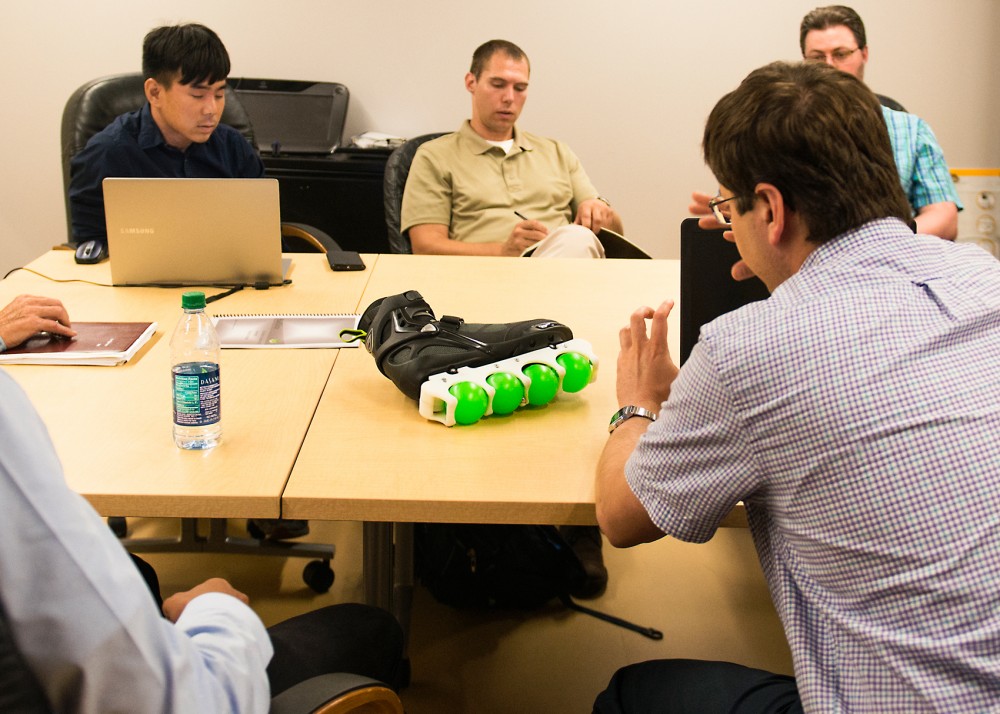From a young age, Henry Cervantes and his seven siblings were pushed to succeed by their single mother.
Now, Cervantes — a California native — has collaborated with the University of Minnesota to invent and build a new kind of in-line roller skate.
The product is a part of his up-and-coming business, BallSkate. Cervantes chose to market the skates in Minnesota because of the state’s connection to in-line skating, he said.
“Throughout the rise of in-line skating, and even throughout the decline, Minnesota has remained one of the active participant states,” Cervantes said.
BallSkate replaces the traditional wheels with balls that allow for more natural braking, Cervantes said.
“In-line skates have an inherent flaw,” Cervantes said. “The flaw is that they use wheels.”
Wheels don’t allow for smooth braking, he said, forcing users to lean back against their natural body movement.
Cervantes said he and his team are still conducting market trials for the skates until September, but hope to release the first versions by 2017.
Throughout the patent process, Cervantes has worked with the University in a program that lets Carlson School of Management students help new business startups.
The project — part of a graduate course called New Product Design and Business Development (NPDBD) — is a partnership between the College of Science & Engineering and the Carlson School, said Mechanical Engineering Professor and Medical Devices Center Director Arthur Erdman.
Cervantes used data and research from the Carlson School to predict sales projections.
“Based on [their] predictions, our product will be a market disrupter,” he said.
The NPDBD course was originally a two-semester course, but was extended into the summer when students became more involved and wanted to continue.
Scott and Brennan Olsen, who founded Rollerblade, recommended Cervantes work with Erdman because he and some graduate students helped develop the first Rollerblades in the late ’80s and early ’90s.
Erdman first met Cervantes last year when he applied to sponsor the course.
Cervantes was a great mentor to the six students, Erdman said, all of whom will have their names on the BallSkate patent.
“I think [Cervantes is] … self-made. He certainly has a lot of gifts,” Erdman said.
MBA Candidate and Business Lead Murid Amini said Cervantes was a driving force, a cheerleader and an advisor for the project.
Collaborating with the University and Minnesota businesses was one of Cervantes’ priorities, Amini said, adding that his approach was one that benefits the local community.
Aside from being a good salesman and businessman, Cervantes is also a loyal and honest person, said his business partner Roland Kessler.
Kessler met Cervantes nearly 20 years ago, and said they instantly clicked.
“He’s good with people and tries to respect everyone,” he said.
Even after having a heart attack and subsequent angioplasty surgery in June, Cervantes was dedicated to BallSkate, said sister-in-law Luckie Leiva.
“He used to spend hours working at nighttime,” Leiva said. “But I think he understands now. … We’re very glad and happy that he’s OK.”
She said Cervantes has always been a hard worker, setting goals and persevering until he reaches them.
Despite his hard work and struggles, Leiva said Cervantes is very down-to- earth.
“Henry has a very humble heart,” Leiva said. “That’s what I like about him.”








